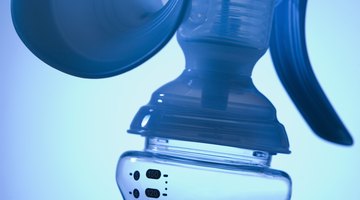How to Use the Avent Manual Breast Pump
The Avent Manual Brest Pump is an ideal way to relieve pressure through engorgement and to pump and store small amounts of milk for your baby to take via bottle when you aren't able to breastfeed.
Manual pumps are best for infrequent pumping, as they take longer than electric pumps to strip the milk from the breast. If you've purchased an Avent Manual Breast Pump, also known as the "ISIS," you must use it properly to ensure the maximum amount of milk removed from the breast at each pumping.
Sterilize and wash the Avent Manual Breast Pump before you use it for the first time. Residue on the plastic can taint the milk, as noted by the Avent Manual Breast Pump instruction manual. Disassemble the parts, unscrew the top and remove the vent. Place all parts in a sink with warm water and antibacterial soap, and swish around. Remove the parts and rinse well before spreading on a towel to air dry.
Assemble the parts by slipping the vent in the inside neck of the main pump body. It should fit snugly over the lip provided. Then, screw on the top portion that holds the pump handle. Slip the inner plastic cone into the pump funnel and screw on the rounded top piece to complete the pump body. Depress the handle a few times to ensure that all the parts are working well.
Relax in a chair, and find a comfortable position. Manual pumping can be tedious and take up to 45 minutes to remove the milk from the breasts completely, notes Baby Center. Milk typically flows better if you are relaxed and focused. Pump in front of the TV or while flipping through a magazine to keep you occupied.
Center the funnel over your bare breast, and press the rim of the funnel around your breast. Your nipple and areola should be in the neck of the funnel while the flesh of your breast rests comfortably in the mouth of the funnel. Hold the funnel against your breast with one hand, and depress the handle with the other. The Avent Manual Breast Pump has silicon petals that stimulate the nipple for better let-down.
Press the handle five to six times; hold to stimulate let-down the same way a nursing baby would. When milk begins to flow, pump consistently as you strip your breast of breast milk. When the milk stops flowing, switch breasts and repeat the process of let-down and pumping.
Store the milk in air-tight containers with the date and time written on the side. Breast milk can stay at room temperature for four to eight hours, in a refrigerator for three to eight days and in the freezer for up to three months, reports Family Doctor, the American Academy of Family Physicians' website.











